You may have diverse opportunities to develop math skills and problem-solving skills but practicing with Eureka Math 3rd Grade Answer Key for better and efficient learning. Eureka Math Grade 3 provided Free Access Student Edition of Eureka Math Grade 3 Answers are enough to practice more and get a good grip on the subject. The diverse opportunities will develop problem-solving skills among the primary school kids Practising.
Engage NY Eureka Math 3rd Grade Module 4 Lesson 13 Answer Key
Fun learning activities are the best option to educate primary school students and make them understand the basic mathematical concepts like addition, subtraction, multiplication, division, etc. Grade 3 primary school students can find these fun-learning exercises for all math concepts through the Eureka Math Answers Grade 3 Common Core Curriculum.
Eureka Math Grade 3 Module 4 Lesson 13 Problem Set Answer Key
Question 1.
Each of the following figures is made up of 2 rectangles. Find the total area of each figure.
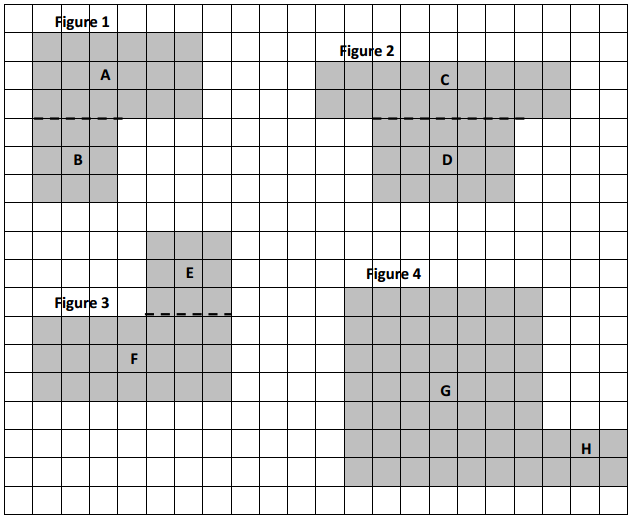
Figure 1: Area of A + Area of B: ____18_____ sq units + _____9____ sq units = _____27____ sq units
Figure 2: Area of C + Area of D: ____18_____ sq units + ___15______ sq units = ___33______ sq units
Figure 3: Area of E + Area of F: _____9____ sq units + ____21_____ sq units = ____30_____ sq units
Figure 4: Area of G + Area of H: _____49____ sq units + ___6______ sq units = ____55_____sq units
Answer:
The total area of figure 1 = 27 sq units.
the total area of figure 2 = 33 sq units.
the total area of figure 3 = 30 sq units.
the total area of figure 4 = 55 sq units.
Explanation:
In the above-given question,
given that,
the area of rectangle A + rectangle B = figure 1.
area of rectangle A = 18 sq units.
area of rectangle B = 9 sq units.
so the area of figure 1 = 27 sq units.
the area of rectangle C + rectangle D = figure 2.
area of rectangle C = 18 sq units.
area of rectangle D = 15 sq units.
so the area of figure 2 = 33 sq units.
the area of rectangle E + rectangle F = figure 3.
area of rectangle E = 9 sq units.
area of rectangle F = 21 sq units.
so the area of figure 3 = 30 sq units.
the area of rectangle G + rectangle H = figure 4.
area of rectangle G = 49 sq units.
area of rectangle H = 6 sq units.
so the area of figure 4 = 55 sq units.
Question 2.
The figure shows a small rectangle cut out of a bigger rectangle. Find the area of the shaded figure.
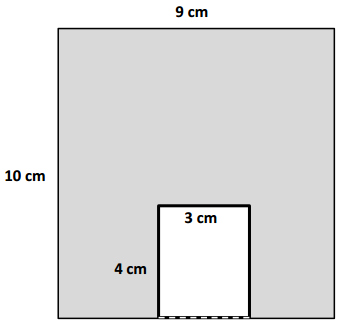
Area of the shaded figure: __90____ – __12____ = ___78___
Area of the shaded figure: ___78___ square centimeters
Answer:
The area of the shaded figure = 78 sq cm.
Explanation:
In the above-given question,
given that,
area of longer rectangle = 90 sq cm.
area = l x b.
area = 9 x 10.
area = 90 sq cm.
area of smaller rectangle = 12 sq cm.
area = l x b.
area = 3 x 4.
area = 12 sq cm.
area of shaded rectangle = area of longer rectangle – area of smaller rectangle.
area of shaded rectangle = 90 – 12.
area of shaded rectangle = 78 sq cm.
Question 3.
The figure shows a small rectangle cut out of a big rectangle.
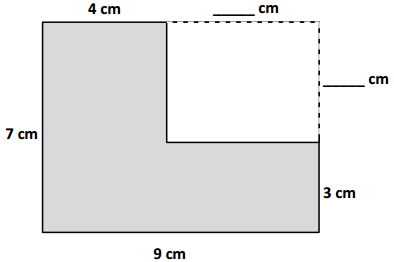
a. Label the unknown measurements.
Answer:
The unknown measurements = 4 cm and 5 cm.
Explanation:
In the above-given question,
given that,
the longer rectangle = 9 x 7 = 63 cm.
9 – 4 = 3.
7 – 3 = 4.
so the unknown measurements = 4 cm and 5 cm.

b. Area of the big rectangle:
___9__ cm × __7___ cm = __63___ sq cm
Answer:
The area of big rectangle = 63 sq cm.
Explanation:
In the above-given question,
given that,
area of the big rectangle = l x b.
where l = length, and b = breadth.
area = 9 x 7 = 63 sq cm.
so the area of big rectangle = 63 sq cm.
c. Area of the small rectangle:
___5__ cm × __4___ cm = ___20__ sq cm
Answer:
The area of small rectangle = 20 sq cm.
Explanation:
In the above-given question,
given that,
area of the big rectangle = l x b.
where l = length, and b = breadth.
area = 5 x 4 = 20 sq cm.
so the area of big rectangle = 20 sq cm.
d. Find the area of the shaded figure.
Answer:
The area of the shaded figure = 43 sq cm.
Explanation:
In the above-given question,
given that,
the area of the longer rectangle = 63 sq cm.
area = l x b.
area = 9 x 7.
area = 63 sq cm.
area of smaller rectangle = 20 sq cm.
area = l x b.
area = 5 x 4.
area = 20 sq cm.
area of shaded rectangle = area of the longer rectangle – the area of the smaller rectangle.
area of shaded rectangle = 63 – 20.
area of shaded rectangle = 43 sq cm.
Eureka Math Grade 3 Module 4 Lesson 13 Exit Ticket Answer Key
The following figure is made up of 2 rectangles. Find the total area of the figure.
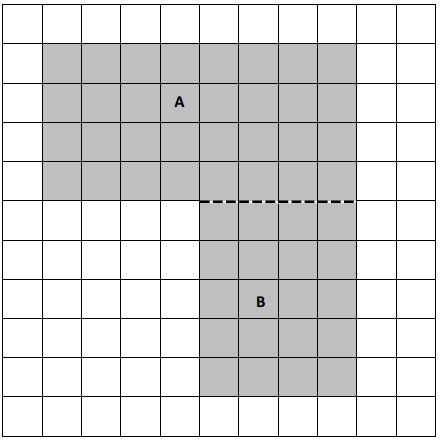
Area of A + Area of B: _____32___ sq units + ____20_____ sq units = ___52______ sq units
Answer:
The area of rectangle A and B = 52 sq units.
Explanation:
In the above-given question,
given that,
the area of rectangle A + rectangle B = figure 1.
area of rectangle A = 32 sq units.
area of rectangle B = 20 sq units.
so the area of rectangle A and B = 52 sq units.
Eureka Math Grade 3 Module 4 Lesson 13 Homework Answer Key
Question 1.
Each of the following figures is made up of 2 rectangles. Find the total area of each figure.

Figure 1: Area of A + Area of B: ____15_____ sq units + ____9_____ sq units = ___24______ sq units
Figure 2: Area of C + Area of D: ___3______ sq units + ____8_____ sq units = ____24_____ sq units
Figure 3: Area of E + Area of F: ___12______ sq units + ____32_____ sq units = ____44_____ sq units
Figure 4: Area of G + Area of H: _____15____ sq units + ____25_____ sq units = ___40______ sq units
Answer:
The total area of figure 1 = 24 sq units.
the total area of figure 2 = 24 sq units.
the total area of figure 3 = 44 sq units.
the total area of figure 4 = 40 sq units.
Explanation:
In the above-given question,
given that,
the area of rectangle A + rectangle B = figure 1.
area of rectangle A = 15 sq units.
area of rectangle B = 9 sq units.
so the area of figure 1 = 24 sq units.
the area of rectangle C + rectangle D = figure 2.
area of rectangle C = 3 sq units.
area of rectangle D = 8 sq units.
so the area of figure 2 = 24 sq units.
the area of rectangle E + rectangle F = figure 3.
area of rectangle E = 12 sq units.
area of rectangle F = 32 sq units.
so the area of figure 3 = 44 sq units.
the area of rectangle G + rectangle H = figure 4.
area of rectangle G = 15 sq units.
area of rectangle H = 25 sq units.
so the area of figure 4 = 40 sq units.
Question 2.
The figure shows a small rectangle cut out of a big rectangle. Find the area of the shaded figure.
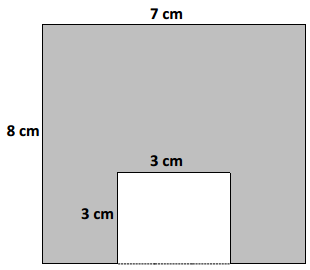
Answer:
The area of the shaded figure = 45 sq cm.
Explanation:
In the above-given question,
given that,
the area of the longer rectangle = 56 sq cm.
area = l x b.
area = 7 x 8.
area = 56 sq cm.
area of smaller rectangle = 9 sq cm.
area = l x b.
area = 3 x 3.
area = 9 sq cm.
area of shaded rectangle = area of the longer rectangle – the area of the smaller rectangle.
area of shaded rectangle = 56 – 9.
area of shaded rectangle = 45 sq cm.
Question 3.
The figure shows a small rectangle cut out of a big rectangle.
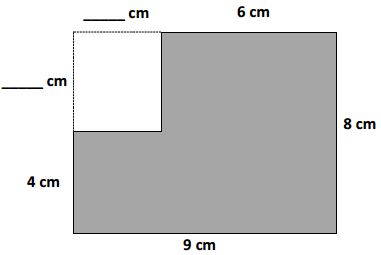
a. Label the unknown measurements.
Answer:
The unknown measurements = 3 cm and 4 cm.
Explanation:
In the above-given question,
given that,
the longer rectangle = 9 x 8 = 72 cm.
9 – 6 = 3.
8 – 4 = 4.
so the unknown measurements = 3 cm and 4 cm.
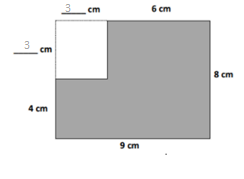
b. Area of the big rectangle:
____9__ cm × ___8___ cm = ___72___ sq cm
Answer:
The area of big rectangle = 72 sq cm.
Explanation:
In the above-given question,
given that,
area of the big rectangle = l x b.
where l = length, and b = breadth.
area = 9 x 8 = 72 sq cm.
so the area of big rectangle = 72 sq cm.
c. Area of the small rectangle:
___3___ cm × ___4___ cm = __12____ sq cm
Answer:
The area of small rectangle = 12 sq cm.
Explanation:
In the above-given question,
given that,
area of the big rectangle = l x b.
where l = length, and b = breadth.
area = 3 x 4 = 12 sq cm.
so the area of small rectangle = 12 sq cm.
d. Find the area of the shaded figure.
Answer:
The area of the shaded figure = 43 sq cm.
Explanation:
In the above-given question,
given that,
area of longer rectangle = 72 sq cm.
area = l x b.
area = 9 x 8.
area = 72 sq cm.
area of smaller rectangle = 12 sq cm.
area = l x b.
area = 3 x 4.
area = 12 sq cm.
area of shaded rectangle = area of longer rectangle – area of smaller rectangle.
area of shaded rectangle = 72 – 12.
area of shaded rectangle = 60 sq cm.
Eureka Math Grade 3 Module 4 Lesson 13 Template Answer Key
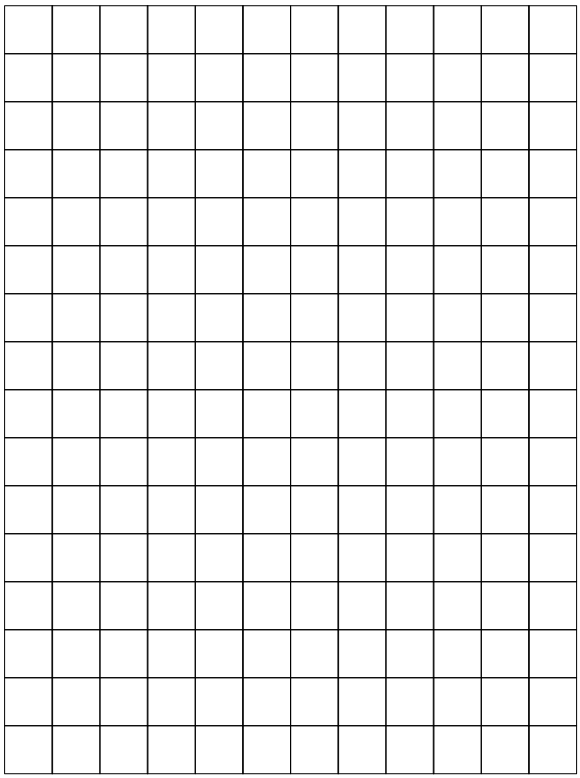
Area of A + Area of B: _____32___ sq units + ____20_____ sq units = ___52______ sq units
Answer:
The area of rectangle A and B = 52 sq units.
Explanation:
In the above-given question,
given that,
the area of rectangle A + rectangle B = figure 1.
area of rectangle A = 32 sq units.
area of rectangle B = 20 sq units.
so the area of rectangle A and B = 52 sq units.
